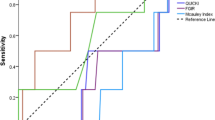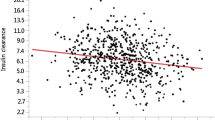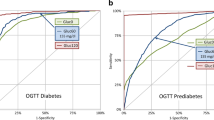Abstract
The aim of this study was to evaluate the validity and reliability of homeostasis model assessment-insulin resistance (HOMA-IR) index, its reciprocal (1/HOMA-IR), quantitative insulin sensitivity check index (QUICKI) and McAuley's index in hypertensive diabetic patients. In 78 patients with hypertension and type II diabetes glucose, insulin and triglyceride levels were determined after a 12-h fast to calculate these indices, and insulin sensitivity (IS) was measured with the hyperinsulinemic euglycemic clamp technique. Two weeks later, subjects had again their glucose, insulin and triglycerides measured. Simple and multiple linear regression analysis were applied to assess the validity of these indices compared to clamp IS and coefficients of variation between the two visits were estimated to assess their reproducibility. HOMA-IR index was strongly and inversely correlated with the basic IS clamp index, the M-value (r=−0.572, P<0.001), M-value normalized with subjects’ body weight or fat-free mass and every other clamp-derived index. 1/HOMA-IR and QUICKI indices were positively correlated with the M-value (r=0.342, P<0.05 and r=0.456, P<0.01, respectively) and the rest clamp indices. McAuley's index generally presented less strong correlations (r=0.317, P<0.05 with M-value). In multivariate analysis, HOMA-IR was the best fit of clamp-derived IS. Coefficients of variation between the two visits were 23.5% for HOMA-IR, 19.2% for 1/HOMA-IR, 7.8% for QUICKI and 15.1% for McAuley's index. In conclusion, HOMA-IR, 1/HOMA-IR and QUICKI are valid estimates of clamp-derived IS in patients with hypertension and type II diabetes, whereas the validity of McAuley's index needs further evaluation. QUICKI displayed better reproducibility than the other indices.
This is a preview of subscription content, access via your institution
Access options
Subscribe to this journal
Receive 12 digital issues and online access to articles
$119.00 per year
only $9.92 per issue
Buy this article
- Purchase on Springer Link
- Instant access to full article PDF
Prices may be subject to local taxes which are calculated during checkout

Similar content being viewed by others
References
Sarafidis PA, Nilsson PM . The metabolic syndrome: a glance at its history. J Hypertens 2006; 24: 621–626.
Reaven GM . Banting lecture 1988. Role of insulin resistance in human disease. Diabetes 1988; 37: 1595–1607.
Hanley AJ, Williams K, Stern MP, Haffner SM . Homeostasis model assessment of insulin resistance in relation to the incidence of cardiovascular disease: the San Antonio Heart Study. Diabetes Care 2002; 25: 1177–1184.
Pyorala M, Miettinen H, Laakso M, Pyorala K . Plasma insulin and all-cause, cardiovascular, and noncardiovascular mortality: the 22-year follow-up results of the Helsinki Policemen Study. Diabetes Care 2000; 23: 1097–1102.
Beck-Nielsen H, Groop LC . Metabolic and genetic characterization of prediabetic states. Sequence of events leading to non-insulin-dependent diabetes mellitus. J Clin Invest 1994; 94: 1714–1721.
Turner NC, Clapham JC . Insulin resistance, impaired glucose tolerance and non-insulin-dependent diabetes, pathologic mechanisms and treatment: current status and therapeutic possibilities. Prog Drug Res 1998; 51: 33–94.
McFarlane SI, Banerji M, Sowers JR . Insulin resistance and cardiovascular disease. J Clin Endocrinol Metab 2001; 86: 713–718.
Sarafidis PA, Lasaridis AN . Actions of PPARγ agonists explaining a possible blood pressure lowering effect. Am J Hypertens 2006; 19: 646–653.
DeFronzo RA, Tobin JD, Andres R . Glucose clamp technique: a method for quantifying insulin secretion and resistance. Am J Physiol 1979; 237: 214–223.
Ferrannini E, Mari A . How to measure insulin sensitivity. J Hypertens 1998; 16: 895–906.
Matthews DR, Hosker JP, Rudenski AS, Naylor BA, Treacher DF, Turner RC . Homeostasis model assessment: insulin resistance and beta-cell function from fasting plasma glucose and insulin concentrations in man. Diabetologia 1985; 28: 412–419.
Katz A, Nambi SS, Mather K, Baron AD, Follmann DA, Sullivan G et al. Quantitative insulin sensitivity check index: a simple, accurate method for assessing insulin sensitivity in humans. J Clin Endocrinol Metab 2000; 85: 2402–2410.
Emoto M, Nishizawa Y, Maekawa K, Hiura Y, Kanda H, Kawagishi T et al. Homeostasis model assessment as a clinical index of insulin resistance in type 2 diabetic patients treated with sulfonylureas. Diabetes Care 1999; 22: 818–822.
Bonora E, Targher G, Alberiche M, Bonadonna RC, Saggiani F, Zenere MB et al. Homeostasis model assessment closely mirrors the glucose clamp technique in the assessment of insulin sensitivity: studies in subjects with various degrees of glucose tolerance and insulin sensitivity. Diabetes Care 2000; 23: 57–63.
Ikeda Y, Suehiro T, Nakamura T, Kumon Y, Hashimoto K . Clinical significance of the insulin resistance index as assessed by homeostasis model assessment. Endocr J 2001; 48: 81–86.
Bastard JP, Rabasa-Lhoret R, Maachi M, Ducluzeau PH, Andreelli F, Vidal H et al. What kind of simple fasting index should be used to estimate insulin sensitivity in humans? Diabetes Metab 2003; 29: 285–288.
Kirwan JP, Huston-Presley L, Kalhan SC, Catalano PM . Clinically useful estimates of insulin sensitivity during pregnancy: validation studies in women with normal glucose tolerance and gestational diabetes mellitus. Diabetes Care 2001; 24: 1602–1607.
Gungor N, Saad R, Janosky J, Arslanian S . Validation of surrogate estimates of insulin sensitivity and insulin secretion in children and adolescents. J Pediatr 2004; 144: 47–55.
Yokoyama H, Emoto M, Fujiwara S, Motoyama K, Morioka T, Komatsu M et al. Quantitative insulin sensitivity check index and the reciprocal index of homeostasis model assessment in normal range weight and moderately obese type 2 diabetic patients. Diabetes Care 2003; 26: 2426–2432.
Yokoyama H, Emoto M, Fujiwara S, Motoyama K, Morioka T, Komatsu M et al. Quantitative insulin sensitivity check index and the reciprocal index of homeostasis model assessment are useful indexes of insulin resistance in type 2 diabetic patients with wide range of fasting plasma glucose. J Clin Endocrinol Metab 2004; 89: 1481–1484.
McAuley KA, Williams SM, Mann JI, Walker RJ, Lewis-Barned NJ, Temple LA et al. Diagnosing insulin resistance in the general population. Diabetes Care 2001; 24: 460–464.
Mather KJ, Hunt AE, Steinberg HO, Paradisi G, Hook G, Katz A et al. Repeatability characteristics of simple indices of insulin resistance: implications for research applications. J Clin Endocrinol Metab 2001; 86: 5457–5464.
Houtkooper LB, Lohman TG, Going SB, Howell WH . Why bioelectrical impedance analysis should be used for estimating adiposity. Am J Clin Nutr 1996; 64 (Suppl): 436S–448S.
NIH Consensus statement. Bioelectrical impedance analysis in body composition measurement. National Institutes of Health Technology Assessment Conference Statement. December 12–14, 1994. Nutrition 1996; 12: 749–762.
Voss EM, Cembrowski GS . Performance characteristics of the HemoCue B-glucose analyzer using whole-blood samples. Arch Pathol Lab Med 1993; 117: 711–713.
Sarafidis PA, Lasaridis AN, Nilsson PM, Pagkalos EM, Hitoglou-Makedou AD, Pliakos CI et al. Ambulatory blood pressure reduction after rosiglitazone treatment in patients with type 2 diabetes and hypertension correlates with insulin sensitivity increase. J Hypertens 2004; 22: 1769–1777.
World Health Organization. Definition Diagnosis and Classification of Diabetes Mellitus and its Complications. Report of a WHO Consultation. Part 1: diagnosis and classification of diabetes mellitus. World Health Organization: Geneva, 1999.
Laakso M, Sarlund H, Mykkanen L . Essential hypertension and insulin resistance in non-insulin-dependent diabetes. Eur J Clin Invest 1989; 19: 518–526.
Kashiwabara H, Inaba M, Maruno Y, Morita T, Awata T, Negishi K et al. Insulin levels during fasting and the glucose tolerance test and Homa's index predict subsequent development of hypertension. J Hypertens 2000; 18: 83–88.
Cheng C, Campbell KL, Kushner H, Falkner BE . Correlation of oral glucose tolerance test-derived estimates of insulin sensitivity with insulin clamp measurements in an African-American cohort. Metabolism 2004; 53: 1107–1112.
Straczkowski M, Stepien A, Kowalska I, Kinalska I . Comparison of simple indices of insulin sensitivity using the euglycemic hyperinsulinemic clamp technique. Med Sci Monit 2004; 10: 480–484.
Conwell LS, Trost SG, Brown WJ, Batch JA . Indexes of insulin resistance and secretion in obese children and adolescents: a validation study. Diabetes Care 2004; 27: 314–319.
Katsuki A, Sumida Y, Urakawa H, Gabazza EC, Murashima S, Morioka K et al. Neither homeostasis model assessment nor quantitative insulin sensitivity check index can predict insulin resistance in elderly patients with poorly controlled type 2 diabetes mellitus. J Clin Endocrinol Metab 2002; 87: 5332–5335.
Diamanti-Kandarakis E, Kouli C, Alexandraki K, Spina G . Failure of mathematical indices to accurately assess insulin resistance in lean, overweight, or obese women with polycystic ovary syndrome. J Clin Endocrinol Metab 2004; 89: 1273–1276.
Lansang MC, Williams GH, Carroll JS . Correlation between the glucose clamp technique and the homeostasis model assessment in hypertension. Am J Hypertens 2001; 14: 51–53.
Chen H, Sullivan G, Yue LQ, Katz A, Quon MJ . QUICKI is a useful index of insulin sensitivity in subjects with hypertension. Am J Physiol Endocrinol Metab 2003; 284: 804–812.
Oterdoom LH, de Vries AP, van Son WJ, van der Heide JJ, Ploeg RJ, Gansevoort RT et al. Validation of insulin resistance indexes in a stable renal transplant population. Diabetes Care 2005; 28: 2424–2429.
Jayagopal V, Kilpatrick ES, Jennings PE, Hepburn DA, Atkin SL . Biological variation of homeostasis model assessment-derived insulin resistance in type 2 diabetes. Diabetes Care 2002; 25: 2022–2025.
Mooy JM, Grootenhuis PA, de VH, Kostense PJ, Popp-Snijders C, Bouter LM et al. Intra-individual variation of glucose, specific insulin and proinsulin concentrations measured by two oral glucose tolerance tests in a general Caucasian population: the Hoorn Study. Diabetologia 1996; 39: 298–305.
Soop M, Nygren J, Brismar K, Thorell A, Ljungqvist O . The hyperinsulinaemic–euglycaemic glucose clamp: reproducibility and metabolic effects of prolonged insulin infusion in healthy subjects. Clin Sci (London) 2000; 98: 367–374.
Bokemark L, Froden A, Attvall S, Wikstrand J, Fagerberg B . The euglycemic hyperinsulinemic clamp examination: variability and reproducibility. Scand J Clin Lab Invest 2000; 60: 27–36.
Author information
Authors and Affiliations
Corresponding author
Additional information
Sources of support: This paper was not supported by any source and represents an original effort on our part.
Rights and permissions
About this article
Cite this article
Sarafidis, P., Lasaridis, A., Nilsson, P. et al. Validity and reproducibility of HOMA-IR, 1/HOMA-IR, QUICKI and McAuley's indices in patients with hypertension and type II diabetes. J Hum Hypertens 21, 709–716 (2007). https://doi.org/10.1038/sj.jhh.1002201
Received:
Revised:
Accepted:
Published:
Issue Date:
DOI: https://doi.org/10.1038/sj.jhh.1002201
Keywords
This article is cited by
-
Insulin resistance, kidney outcomes and effects of the endothelin receptor antagonist atrasentan in patients with type 2 diabetes and chronic kidney disease
Cardiovascular Diabetology (2023)
-
The association of breast feeding for at least six months with hemodynamic and metabolic health of women and their children aged three years: an observational cohort study
International Breastfeeding Journal (2023)
-
Multiple beneficial effects of 1-year nutritional–behavioral intervention on anthropometric and metabolic parameters in overweight and obese boys
Journal of Endocrinological Investigation (2023)
-
Development and validation of dietary and lifestyle insulinemic indices among Iranian adult population
Nutrition & Metabolism (2022)
-
The effects of high-intensity functional training on cardiometabolic risk factors and exercise enjoyment in men and women with metabolic syndrome: study protocol for a randomized, 12-week, dose-response trial
Trials (2022)



